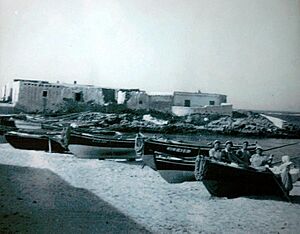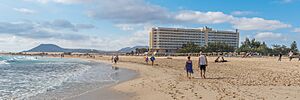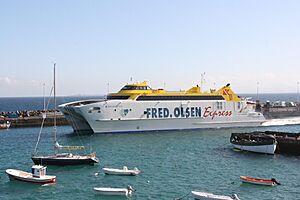Corralejo facts for kids
Quick facts for kids
Corralejo
|
|
|---|---|
|
Town
|
|
| Country | Spain |
| Autonomous community | Canary Islands |
| Province | Las Palmas |
| Island | Fuerteventura |
| Municipality | La Oliva |
| Time zone | UTC0 (WET) |
| • Summer (DST) | UTC+1 (WEST) |
Corralejo (pronounced kora-LE-ho) is a lively town and popular holiday spot. It is located on the northern tip of Fuerteventura, one of the beautiful Canary Islands. From Corralejo, you can see the smaller island of Lobos across the water. It is part of the La Oliva area.
The Atlantic Ocean surrounds Corralejo to the north and east. To the south, you'll find amazing sand dunes. To the west, there's dry desert land that stretches to the coast and El Cotillo. Corralejo was once a quiet fishing village. Now, it is one of the two main tourist towns on Fuerteventura. Many people from different countries live here, including Spanish, Italian, Irish, British, German, and Finnish residents.
The area boasts about 7 kilometers (4.3 miles) of soft, sandy beaches. These start about 2 kilometers (1.2 miles) outside Corralejo. There are also smaller bays along the coast. Nearby, you can explore several kilometers of sand dunes. These dunes are so special that they are a nature reserve. The ocean water around Corralejo is very clear and a deep blue. However, it can have strong currents. The town's own beaches are a bit more sheltered. They have a strip of volcanic rock along the shore.
Contents
History of Corralejo
Early Explorers and Conquest
The area where Corralejo is today was an important landing spot. In 1402, an explorer named Gadifer de la Salle first arrived here on Fuerteventura. He was part of an expedition led by Jean de Béthencourt. They had landed on Lanzarote earlier that year. There, they made a peace deal with the locals. They also built a fort to plan their conquest of Fuerteventura.
Béthencourt stayed on the ship during their first landing on Fuerteventura. La Salle and Remonnet de Levedan went ashore to explore. They wanted to find local people. The northern part of the island was very dry and not many people lived there. The explorers found little sign of local life.
While La Salle was exploring Fuerteventura, a problem arose on Béthencourt's ship. Some men started a mutiny. They wanted Béthencourt to go back to Europe for supplies. While Béthencourt was away, La Salle returned to Fuerteventura. He landed again near Corralejo in October 1402.
They first stopped at Lobos Island, which is about 2 kilometers (1.2 miles) northeast of Corralejo. They hunted seals there for food and skins. After a few days, La Salle sent Levedan back to Lanzarote for water. Lobos Island has no fresh water. Another mutiny happened on Lanzarote. The boat Levedan was on was taken over by rebels. This left La Salle and his men stuck on Lobos Island without food or water. Luckily, loyal men from Lanzarote used a small boat to rescue them.
How the Town Began
People say Corralejo was founded around 1810. Others think a real settlement didn't start until the 1850s. The first people in Corralejo built their homes using local stone. The town's name might come from the area's past use for coastal cattle. Corralejo stayed a small fishing village until the mid-1900s. It relied on the nearby town of La Oliva and goods from other places.
Wind was very important for daily life. Fishermen needed wind to sail their boats. Without it, they had to work much harder to catch fish. The best fishing spots were far from the harbor. Also, windmills needed wind to grind grain into gofio, a basic food. If there was no wind, people had to wait for days. Long lines would form at the mills until the wind returned.
The first settlers came from Lanzarote, Galicia (Spain), or even Portugal. Surnames like Carballo, Estévez, Hierro, de León, Umpiérrez, and Figueroa are some of the oldest. Until the 1950s, there were only about 11 surnames in the whole town. The population was just over 100 people. Many families were related.
The old town chapel, Our Lady of Mount Carmel, was built in 1925. Fishermen worked together to build it. This chapel is no longer there. A more modern church replaced it in the 1980s.
Corralejo as a Tourist Destination
For most of its history, Corralejo was a simple fishing village. Fishermen worked hard to support their families. In the early 1970s, tourists started to discover the north of the island. They were drawn by Corralejo's amazing beaches and huge dunes. Tourism had already begun in the south in the 1960s.
At first, Corralejo was a very basic tourist spot. A writer named John Mercer visited in the early 1970s. He wrote that the village was "unattractive and quite without interest." He wondered why anyone would want to stay there while it was still being built. He even said it would be "simply a spreading building site."
But Mercer was also right about its future. Tourism grew a lot in the 1970s, 1980s, and 1990s. It reached its peak in the 2000s. Many hotels, apartments, and villas were built. Many British and Irish tourists loved the place so much they moved there. This growth in tourism made the population of Corralejo and the La Oliva region grow a lot. In 1975, La Oliva had 2,900 people. By 2022, it had over 28,000!
Throughout the 2010s, the town kept growing. New businesses opened and closed often. The town center is also becoming more friendly for walkers. The main street was made pedestrian-only around 2017. Some locals have had different opinions about this change. Sadly, there has been some vandalism. For example, a replica of the Santa Maria ship at an old theme park was burned down in 2019. But even with these challenges, tourism is still strong. Thousands of people visit Corralejo every year.
Getting Around Corralejo
Corralejo has a good transport system. You can use public buses or taxis. The main bus service, called Tiadhe, connects Corralejo to other towns. Bus number 6 goes to Puerto del Rosario, the island's capital. Bus number 3 goes from Puerto del Rosario to Caleta de Fuste and the Fuerteventura Airport. Bus number 1 goes all the way to the south of the island, to Morro Jable. Taxis are also available for rides around town or to beaches, the airport, and other interesting places.
Ferries regularly travel between Corralejo's port and Playa Blanca in the south of Lanzarote. This makes it easy to visit the neighboring island!
Sports in Corralejo
Corralejo is home to the CD Corralejo football (soccer) team. This team was formed in 2005. The town also has the Onexe Fuerteventura SUP team. This standup paddleboarding club has won the most titles in Spain!
See also
 In Spanish: Corralejo (La Oliva) para niños
In Spanish: Corralejo (La Oliva) para niños







